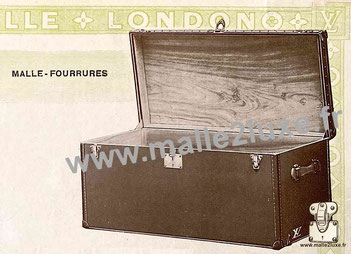- Accueil
- Louis Vuitton
- Modeles
- Toiles
- Serrures
- Lozines
- Etiquettes
- Séries
- Expertise
- Prix du neuf
- Record enchère
- Stars LV
- Contrefaçon
- Nouveauté 2025
- Vanity
- Valise
- Cabine
- Courrier
- Wardrobe
- Automobile
- Fourrure
- Chaussures
- Ideale
- Aluminium
- Explorateur
- Malle à fleurs
- Cadeau VIP
- Jouets
- Chapeau
- Leopold Stokowski
- Albert Kahn
- Tableau
- Lit
- Tiroirs
- Bibliotheque
- Aéro
- Cigare
- Pique-nique
- Alcool
- Pêche
- Marmotte
- Steamer Bag
- Vermeer
- Vendôme
- Georges Vuitton
- Gaston Vuitton
- Homme cible
- Sac petite malle
- Goyard
- Moynat
- Hermès
- Malle ancienne
- Entretenir sa malle
- Estimation
- Lexique
- Décoration
- Personnalisation
- Etiquette Hotel
- Blog
- Louis Vuitton
- Contact
- Ateliers
- Tutoriel : Fabriquer sa malle
- Boutique
LOUIS VUITTON TRUNK - CAMPHOR WOOD
Malle Louis Vuitton à fourrure

Extract from the Louis Vuitton 1914 catalog (Page 13):
TRUNKS - FUR: On the outside, similar to our usual trunks, these trunks are internally lined with wood
of camphor and have a hermetic closure; they are essential for people who, changing climate during a trip, want to keep their furs safe from insects.
They come in all sizes and qualities .
HISTORY OF CAMPHOR WOOD CHESTS
The camphor wood chest is essential for the conservation of furs , the peculiar smell persists for several years. This insect repellant repels moths.

Traditionally, manufacture antique chests wooden massive fact of assembly boards dovetail , corners and brass hinges.
Around 1940
The camphor wood chest
Dimension: 41 x 95 x 45
Some call it "naval officer chests" but this name is fanciful, the fur is not the dress of the officers.
RAW WOOD TIP:
This wood is never varnished or waxed of origin, just like the cedar wood of Lebanon, it is left raw so as not to trap the aromas that keep pests away. It is therefore obvious not to varnish it or apply any other products.
HISTORY AND USE:

The camphor tree or camphor tree (Cinnamomum camphora) is a species of Lauraceae trees, native to China, it has become widespread in other continents. Part of the family of angiosperm plants of old divergence, which includes more than 2000 species distributed in about fifty genera including Laurels.
They are trees or shrubs with almost evergreen leaves.
Camphor wood is used in two ways:

- Wood essential oil : its most common uses. Since the 12th century in Europe, camphor has been extracted by distillation of: branches, bark, leaves, roots ... In Madagascar, it is called "ravintsara" and the "wood of Ho" is extracted there its essential oil contains sofrol (toxic) which is used externally for its antiviral, antiseptic, respiratory stimulant, cardiac ...
Camphor is the major ingredient in "tiger balm".

- Solid wood furniture : wood is hardly ever used in carpentry or cabinet-making, very little in "camphor burl" marquetry. Its use in solid wood is more for its insect repellent characteristics, than for its aesthetic appeal. Only the trunk-makers and chests use camphor wood (between 1910 and 1970) for the manufacture of luggage intended for the transport of valuables and furs. Total or partial manufacturing. At Louis Vuitton and Goyard, for example, the fur trunks were lined with 10 to 15 mm panels of camphor tree nailed to the inside in order to keep moths away.
Also the camphor tree would prevent the silver from tarnishing.
CAMPHOR CHARACTERISTIC

Family : Hardwood
Tree height : 20 - 30 m
Trunk diameter : 0.6 - 1.2 m
Average density : 520 kg / m3
Janka hardness : 4440 N
Modulus of rupture : 80.5 MPa
Elastic modulus : 1,676,000 GPa
Narrowing :
- Radial : 3.1%
- Tangential : 5.4%
- Volumetric : 8.7%
- T / R ratio : 1.7
Provenance today : Native to South-East Asia, widely planted in the tropics and subtropics around the world: Réunion, Madagascar, Asia.

Color : possibly very variable depending on species and growing conditions; usually a light brown, often with undertones of gray, red or olive green. Sometimes contains darker streaks. The paler sapwood is not always clearly differentiated from the heartwood. Brambles are also commonly seen and are considered very decorative.

Texture : grain can be straight, interlocking and / or wavy. Uniform medium texture with a high natural shine and a slightly greasy feel.
Rot resistance : classified as durable, with mixed resistance to various insect attacks.
Common use : Veneer, turned objects, chests, Insect repellent cabinets and furniture, Essential oil.

Workability : The moderate density of camphor makes it easy to shape and machine with minimal effort. Areas of interlocking grain can cause pullout problems, but complications are usually minimal. Sticks and finishes well.
Odor : Camphor has a very characteristic odor, for which the tree is named. The most recognizable product that contains the camphor extracts is the Medicated Breast Rubs, which have the same distinct scent.
Allergies / Toxicity : Camphor has been reported to cause skin and respiratory irritation, as well as a number of other effects, such as headache, dizziness and asthma symptoms. See the articles Allergies and Wood Toxicity and Wood Dust Safety for more information.
Price / Availability : Rarely, if ever, exported as lumber, most camphor is exported from Asia in the form of burl veneer. Timber, turning blanks and log sections are sometimes seen for sale from national sources where the tree was introduced and harvested locally. The prices of these “domestic” exotic species are generally in a moderate range compared to other imported hardwoods. Massive brambles and veneer sheets are much more expensive.
Malle à fourrure en bois de camphrier : French page
Copyright © 2008-2025 Malle2luxe Paris. Tous droits réservés.

